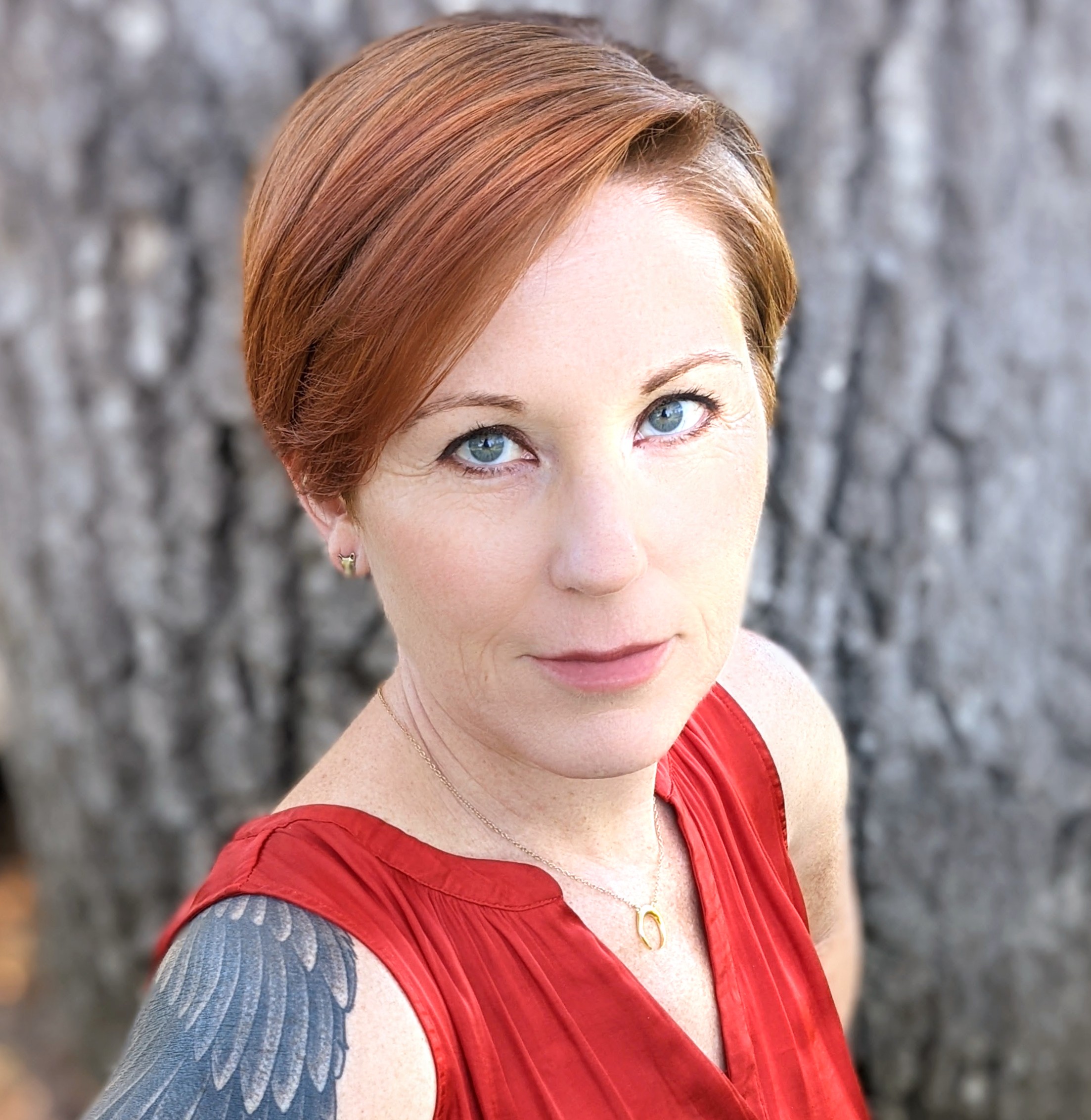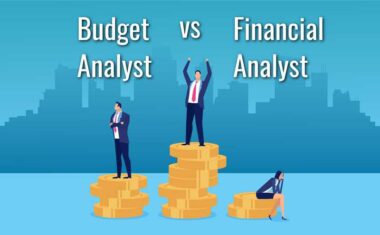This Springboard Grad Used Data Analytics to Combat the Rising Cost of Higher Education
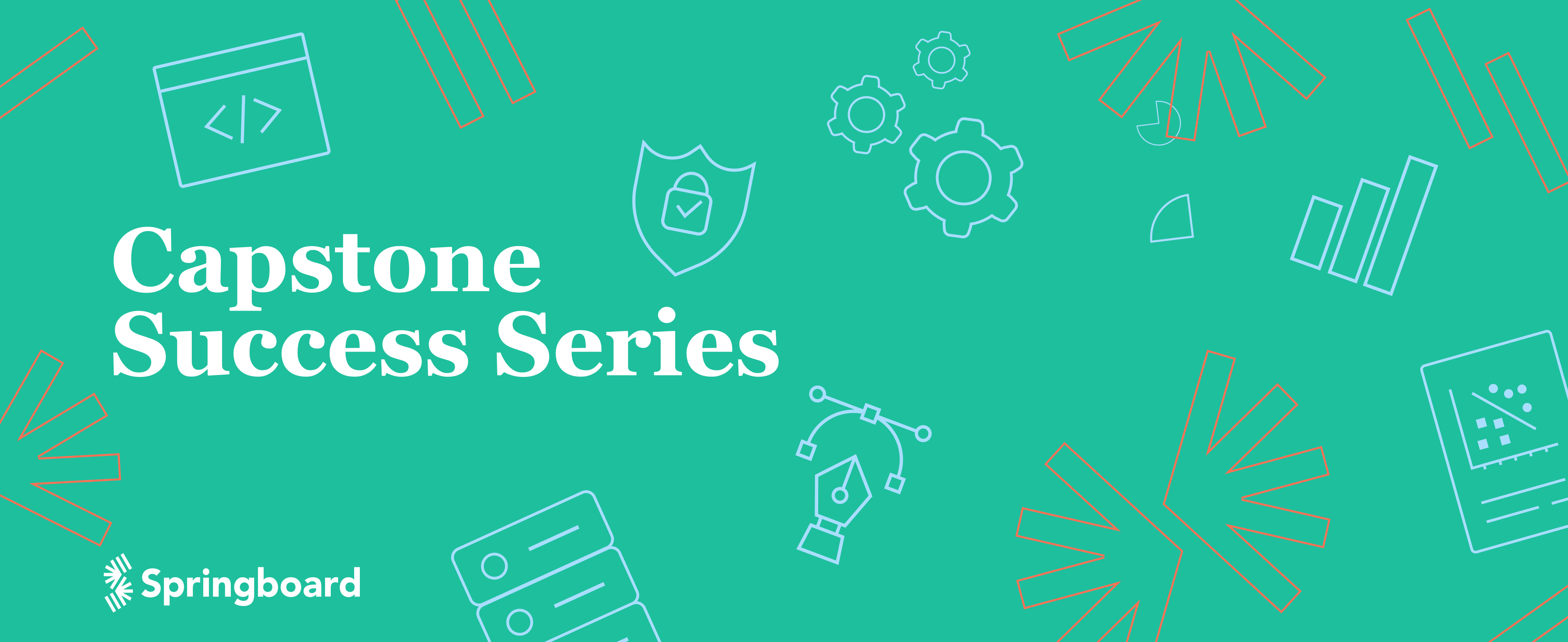
In this article
- Dataset: Analyzing the cost and popularity of a college degree...
- The cost of college tuition has skyrocketed since the 1980s
- Megatrends: Pivotal moments in higher education
- Megatrends: Student diversity in higher education enrolments
- Megatrends: In-state college tuition and fees for public institutions
- Takeaway: College tuition costs are just the beginning of the...
After attending university for free in her native Romania and even receiving a modest, government-issued stipend for getting good grades—“It was only enough to buy lunch,” she laughs—Iulia Tomescu balked at the expense of sending her son to college in the US.
“My number one concern was saving for retirement, but paying for my son’s college education was my number two concern, and I was terrified when I saw those high [tuition costs],” says Tomescu, a single parent whose son was only two years old when they arrived in the US more than 20 years ago.
It’s no secret that the cost of a four-year degree has climbed steadily over the last few decades. The average cost of tuition, fees, room, and board for 2019-2020 was $22,189 for one year as an in-state student at a state school (the least expensive option) and $50,7770 for a private school, according to College Board. That adds up to $88,720 for four years at a state school and a colossal $203,080 at a private college. Overall, the sticker price for a four-year degree has risen 5% annually over the last 10 years.
Worse still, the data shows that families tend to underestimate the costs of college. Roughly 1 in 4 high school parents surveyed by Fidelity believed that the full cost of college would be $5,000 per year or less, far below CollegeBoard’s estimate.
While enrolled in Springboard’s Data Analytics Career Track, Tomescu wanted to explore a facet of the socioeconomic landscape that had been forever changed by the pandemic for her capstone project. But instead of analyzing datasets on vaccination rates and hospital admissions, Tomescu wanted to focus on something more personal.

“Thankfully, my son was in his final year of college when the pandemic hit, but I saw my friends with college-age kids struggling to justify the cost of tuition,” said Tomescu. “During the COVID pandemic especially, people felt very frustrated about having to pay for something that was already expensive and justify those expenses even while kids were staying home.”
A fraught job market, college debt crisis, and virtual schooling induced by the COVID-19 pandemic have rendered college a far less appetizing prospect of late. A recent survey of high school students found that the likelihood of attending a four-year school sank nearly 20% in less than a year, down to 53% from 71%, according to ECMC Group.

“There was no education model for studying from home, and there are many fees involved in going to school aside from tuition,” said Akshay Jhawar, manager of data science and engineering at Bajaj Finserv in Pune, and Tomescu’s mentor during her Springboard course. “To be fair to schools, many of them didn’t know how to react to the pandemic.”
Many students are opting for cost-effective alternatives such as bootcamps, community college, trade school, and certification programs, many of which offer a more practical focus than a degree program. Overall, undergraduate enrollment fell more than 4% in 2020, according to data from National Student Clearinghouse Research Center.
Get To Know Other Data Analytics Students
Sarah Savage
Content Data Analyst at EdX
Sylwia Padiasek
Senior Research Analyst at Gro Intelligence
Bart Teeuwen
Global Business Analyst, Global Talent Intelligence (GTI) at Meta
Dataset: Analyzing the cost and popularity of a college degree over time
Tomescu compiled a dataset that would allow her to compare the costs of tuition and fees at public vs. private institutions for in-state and out-of-state students, understand the different cost components of a college education (eg: room and board), and how these costs changed over time. Ultimately, her goal was to analyze these variables in relation to historical enrollment numbers to arrive at an understanding of how rising tuition costs have affected demand for a four-year degree.
She used a Kaggle dataset consisting of data from a range of different sources. This dataset contained the historical averages for tuition and fees from the US Department of Education’s National Center for Education Statistics spanning from 1985-2016. She also compiled data on tuition and fees by college and university from 2018-2019 from the Chronicle of Higher Education, along with school type (public vs. private) degree length, in-state, out-of-state, state.
Tuition and fees at a nationwide level (1968-2019)
- Total costs for public vs. private 4-year undergraduate degrees
- Total costs vs. tuition & fees, room and board rates
- Total enrollment vs. gender enrollment
Tuition and fees at the state level (2010-2019)
- In-state vs. out-of-state tuition and fees
The cost of college tuition has skyrocketed since the 1980s
Rising tuition fees are threatening the affordability and access of university education in the US.
Tomescu found that over the last 50 years (1968-2019), the costs for private and public institutions increased by 270% and 250% respectively (about 50% per decade or 5% per year). During that time, the tuition gap between private and public institutions grew by about 2%, with private institutions exhibiting a higher cost variability than public schools. The average cost distribution for private schools ranged between $16,000-$45,000; for public schools, it was $8,000-$21,000.
While tuition costs rose at a far faster rate at private institutions than public schools, enrollment remained relatively flat, suggesting that private school students are less price-sensitive than those at public schools. In a traditional market, the demand for a good is inversely proportional to price.
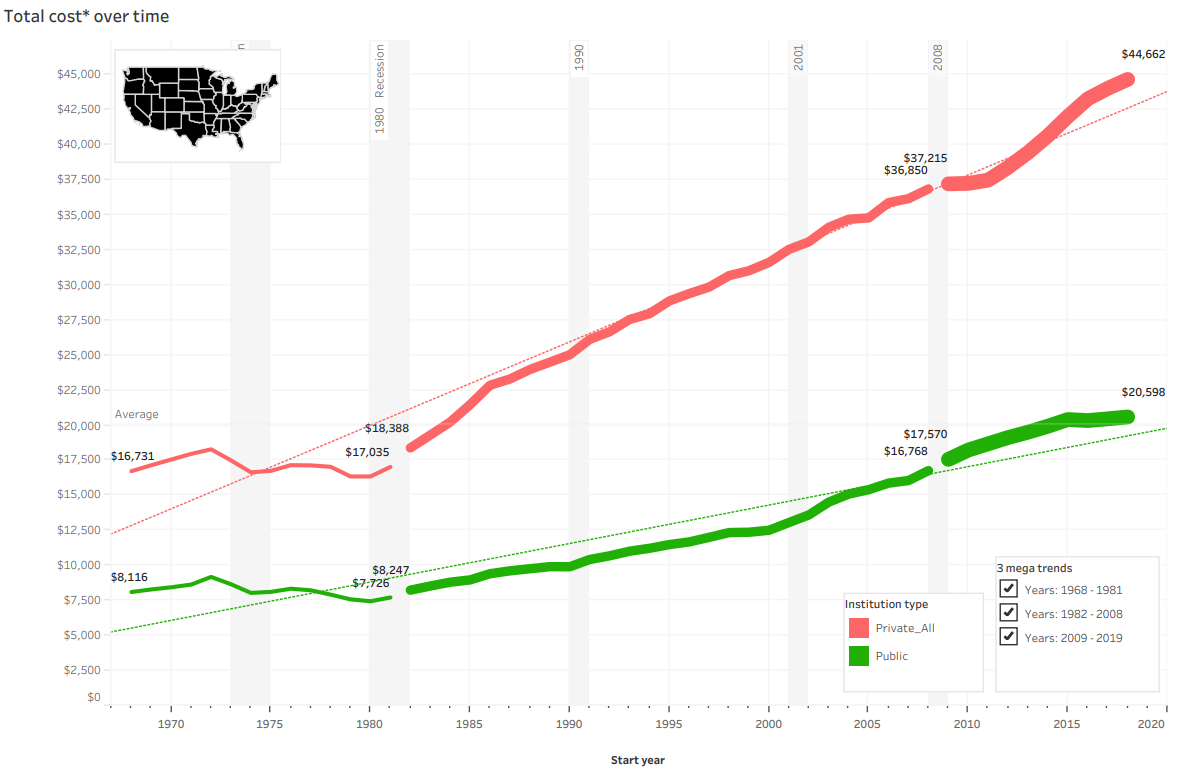
“The private sector doesn’t really abide by the rules of supply and demand,” said Iulia. “There is a monopoly, so they can increase the prices as much as they want and enrollment stays flat.”
Government underinvestment in the public education system leads to a massive prestige gap between private and public institutions, hence why private schools can raise their prices continuously without jeopardizing enrollment. Secondly, many students rely on college rankings as a proxy for their own educational outcomes. Many of the metrics used to calculate college rankings, such as expenditures per student, average class size, and faculty compensation put public schools, which have fewer resources, at a disadvantage.
Finally, college selectivity is overestimated as a reliable indicator of future earnings, job satisfaction, and student wellbeing, which makes a private education more price-inelastic (demand remains constant even as prices increase) than public education.
In her analysis, Tomescu recognized three cost components that make up the total cost of a four-year degree: tuition & fees, board, and dormitory. Tomescu wanted to understand the variation of these cost components over time. Predictably, tuition & fees represented the largest cost component for both public and private institutions. At private universities, tuition & fees constitute 70% of the total cost, at $31,875, whereas costs are spread more evenly at public institutions, representing 40% of the total cost of attending college, at $9,212.
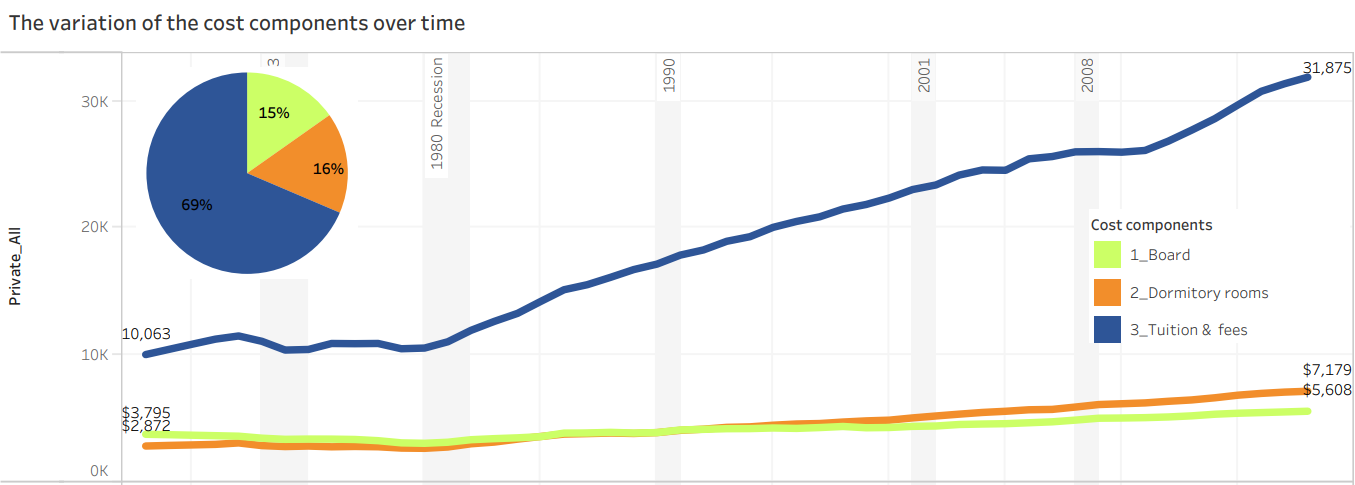
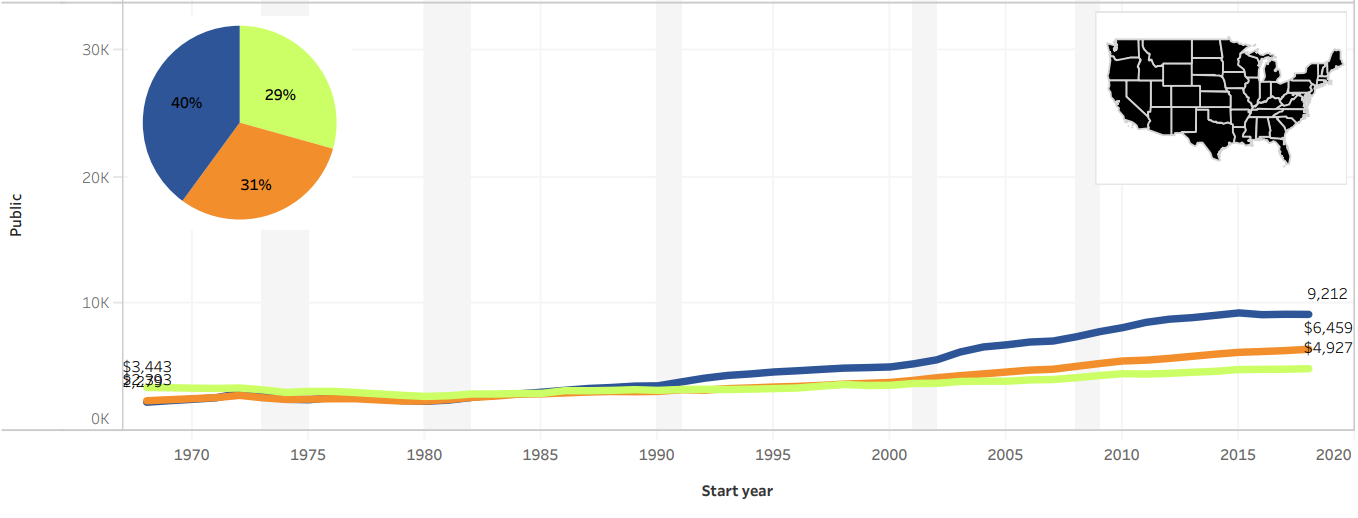
The ancillary costs of obtaining a college degree—room and board—were primarily driven by the increase in tuition and fees, which almost tripled for both public and private institutions. As you can see from Tomescu’s graph (above), tuition & fees rose much faster relative to the cost of room and board—particularly for private institutions.
On average, tuition & fees represent 60% of the cost of going to college for both public and private institutions; student accommodation comprises 20%, and board takes up 20%.
Megatrends: Pivotal moments in higher education
Despite an overall upward trend in the cost of attending a four-year university over the last 50 years, Tomescu noted three anomalistic periods in the years 1968-1981; 1982-2008; and 2009-2019. She dubbed these “megatrends” to describe the changes that occurred during these periods.
1: The 70s and 80s marked extreme highs and lows in tuition rate changes
In the early 1970s, college costs continued to rise at a rate of 2-3% per year, but still lagged behind inflation. Then, in the mid-1970s, the nation experienced the worst economic recession since the Great Depression—a 16-month long contraction from 1973 to 1975—and the pool of potential college students shrank.
At this point, the Higher Education Act of 1965 had recently passed, which provided access to financial aid (FAFSA), namely, the Pell Grant and Stafford loans (direct subsidized or unsubsidized loans) that exist today. Starting in 1975, college tuition began to outpace the rate of inflation by 5-6% as enrollment picked back up again. This uptick persisted through the early 1980s.
According to UPI, the rapid rise in college costs during the 1980s occurred as schools decided to compete for students by improving quality rather than lowering prices. They did this by offering more financial aid and better facilities and services, leading to higher tuition. College costs increased about 9% a year in the 1980s, about twice the overall inflation rate, and faster than the median family income, which was going up at a median rate of 5.6% per year, and faster than any recent time in decades.
Interestingly, data shows that during economic recessions, college enrollment tends to creep upwards as laid-off workers seek to upskill or re-skill, which allows institutions to raise their prices without losing profits.
2. The early 80s to late 2000s showed a general decreasing change rate trend
From the 1980s to the early 2000s, college tuition continued to climb, albeit at a slower rate, amounting to an overall decreasing change rate, as seen here in Tomescu’s graph. For example, in 1983, tuition and fees saw a 6.8% increase compared to the year before, the highest jump until that point. Over the next two decades, college tuition would continue to climb, albeit at a slower rate. We see here in Tomescu’s graph that while the enrolled population soared, so did tuition costs. Below, the green line indicates public institutions and red line indicates private.
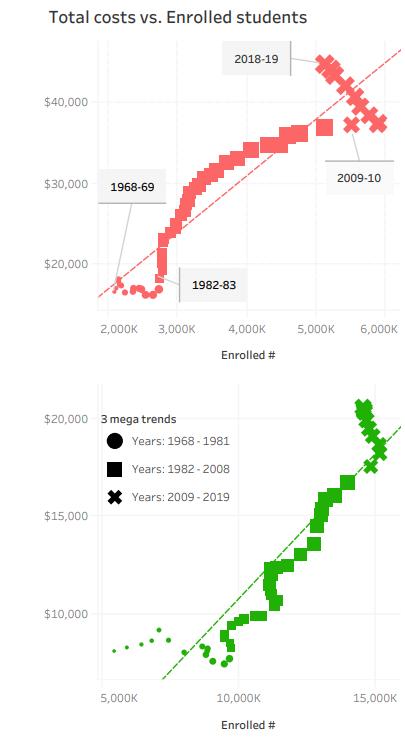
“Since the early ‘80s, people had to pay more out of pocket to access education, whereas before the government had assumed more of the costs,” said Tomescu. “While people enjoyed lower taxes, they were expected to pay more for various things.”
3. Costs vs. enrollment: how does demand change according to the price?
Tomescu found that the overall increase in costs is a reflection of higher demand over time for both public and private institutions, shown by growing enrollment numbers. However, costs went up much faster than enrollment rates, especially at private institutions.
4. In the early 2010s through 2019, the private sector records increasing change rates and the public sector records decreasing change rates
The overall increase in costs is a reflection of higher demand over time for both public and private institutions. Also, deep state cuts in funding for higher education have contributed to significant tuition increases and passed on most of the costs to students.
However, Tomescu found a negative correlation between costs and enrollment for the last 10 years. According to her data, enrollment consistently increased from the 60s’ until the late 2000s, followed by a steady decrease since then.
5. Female enrollment has outpaced male enrollment since 1982
Female enrollment has topped male enrollment since 1978-1979, the last time the gender distribution was 50%.
“This phenomenon is related to the women’s movement, which started in the ‘60s but really peaked in the mid-70s,” Tomescu explained. “Women didn’t want to be as dependent on men, but they didn’t have access to jobs that didn’t require a college degree because those [often labor-intensive] jobs were being filled by men, so they had to go to college to get ahead.”
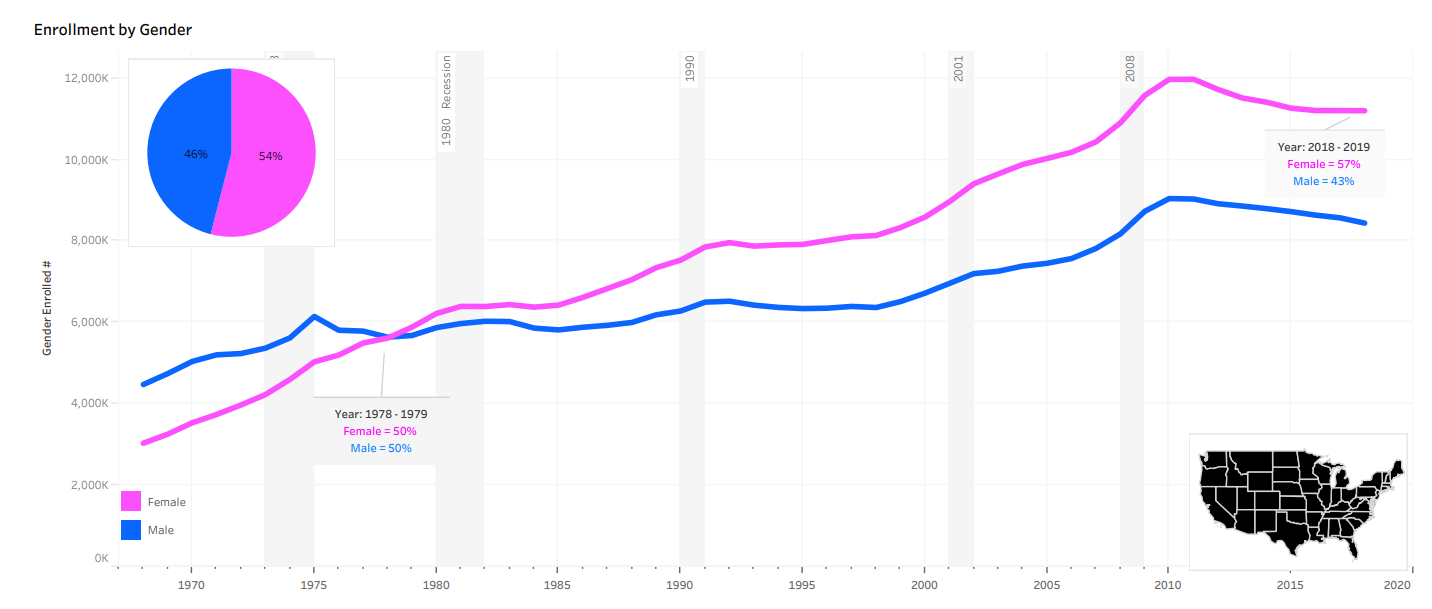
The gap between male and female enrollment grew to 7% in 2019, where females represented 57% of the enrolled population, and males just 43%. Recent headlines show that this trend has increased in response to the pandemic, as the number of men enrolled at two-year and four-year colleges has fallen behind women by record levels.
“At the close of the 2020-21 academic year, women made up 59.5% of college students, an all-time high, and men 40.5%, according to enrollment data from the National Student Clearinghouse,” writes Douglas Belkin for the Wall Street Journal. “U.S. colleges and universities had 1.5 million fewer students compared with five years ago, and men accounted for 71% of the decline.”
Megatrends: Student diversity in higher education enrolments
Tomescu found that the size of the enrolled population is not correlated with diversity, but is more contingent on the diversity of the general population to begin with.
This is especially true for public universities, which tend to see lower out-of-state enrollment than private universities. She crunched the numbers on race and ethnicity of the enrolled population from 1968-2019 to find average diversity. She then ranked the states according to diversity, with Hawaii and California coming out on top, with Rhode Island and Oklahoma at the bottom, with a student population that is over 70% white. California, the second most diverse state with an overwhelmingly Hispanic population, also has the largest enrolled population.
The overall average enrolled population across all states is 57% white, 16% Hispanic, 14% Black, 6% Asian, and 7% other. California is the state with the highest total enrollment and an overwhelmingly Hispanic enrolled population. Alaska has the lowest total enrollment. Hawaii has the most diverse enrolled population, while Rhode Island is the least (around 75% white).
“The bigger the university, the harder it is to keep that balance in diversity,” said Tomescu.
Megatrends: In-state college tuition and fees for public institutions
Public institutions are partially funded by state taxes, which are paid by the state’s residents. Schools charge non-residents an out-of-state tuition premium seeing as they do not pay taxes in that state. These in-state and out-of-state differentials also help to convince prospective students to remain in-state for their schooling, thereby helping to maintain the state’s tax base.
According to Tomescu’s analysis, the average in-state tuition for public universities overall is $9,000. The most expensive state for in-state students is New Hampshire, charging $14,815 per year, compared with Wyoming, where a year of college for residents costs just $4,055.
Meanwhile, out-of-state students pay double, triple, or even quadruple the amount paid by residents. The average ratio between in-state and out-of-state tuition is 2.7. Florida has the highest, at 4.1, where in-state tuition is $4,342, while out-of-state tuition costs $17,753. Meanwhile, South Dakota has the lowest differential at a ratio of 1.4. In states with above-average in-state tuition to begin with, such as New Hampshire, Pennsylvania, and Illinois, the increase between in-state tuition and out-of-state tuition is closer to 200%.
Research shows that out-of-state students are much less price-sensitive than in-state students. This is because in-state students generally have fewer alternatives (and resources), so they will go to college no matter the cost, whereas students who go out of state for their education tend to go for prestigious institutions with name recognition.
“The rate of increase for out-of-state tuition is truly a demand response,” said Tomescu. “Young people increasingly want to go out of state and leave home. At public institutions, we see this demand-supply response a lot more than in private institutions.”
When it comes to cost increases over time, Iulia found that out-of-state costs increase faster than in-state costs. In general, out-of-state tuition is 3x higher than in-state tuition—and that cost distribution has only grown over the years. Between 2018-2019, the cost distributions between in-state and out-of-state tuition were higher than ever, ranging from about $12k-$40k.
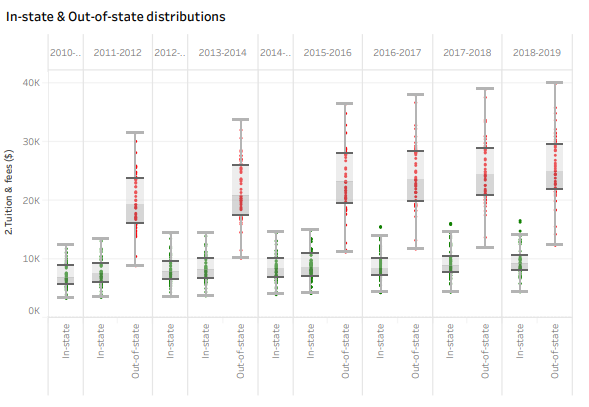
Takeaway: College tuition costs are just the beginning of the higher education conundrum
After being laid off from her job as a senior geologist in May 2020, Tomescu threw herself into the Data Analytics Career Track at Springboard with the hopes of switching into a more data-focused role. “I wanted to take full advantage of the fact that I was unemployed and learn every second of it,” she said. “This course has been my class for the last nine months and I loved every second of it.”
Jhawar, who helped Tomescu refine her idea and bring her capstone project to life, says he was impressed by her dedication. “She had the story written out in a notebook–she had planned it out and done the groundwork to make sure she could tell a story with the data,” he said. “She is very, very dedicated.I think she could be a mentor to me.”
Tomescu says the datasets she selected are just a starting point, and that there are many more questions pertaining to college enrollment that she wanted to explore but was unable to due to time constraints. For example, quantifying the value of community colleges, or examining what factors affect student diversity at individual colleges, how the amount of debt a student graduates with varies by institution, and which colleges and college degrees promise the highest ROI. When choosing a college and a major, young people (and the parents of soon-to-be-college students) face innumerable unknowns—many of which can be illuminated using data analysis. (here is more about choosing career as a Data Analyst).
“The main audience for this analysis is young adults who have just started thinking about who they want to become,” said Tomescu. I have a sense that college is overrated considering the debt risk people are facing in this country.”
However, the most niggling question of all for Tomescu (and millions of college-age youth) is this: if the cost of college tuition continues to rise, at what point does a college degree provide diminishing returns?
“What is the threshold at which it would no longer make sense to attend college?” said Tomescu. “This could really help parents decide how much investment and risk they can afford for their children’s higher education.”
Since you’re here…
Switching to a career in data analytics is possible, no matter your background. We’ve helped over 10,000 students make it happen. Check out our free data analytics curriculum to gauge your interest, or go all-in with our Data Analytics Bootcamp.
